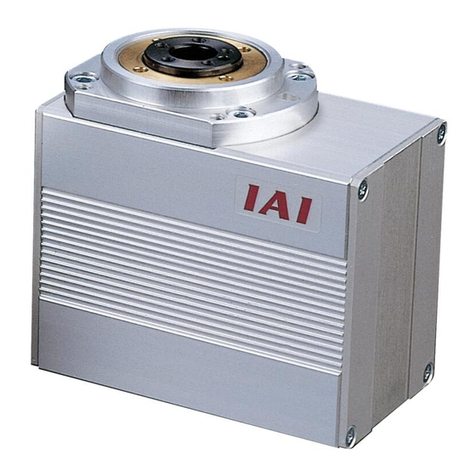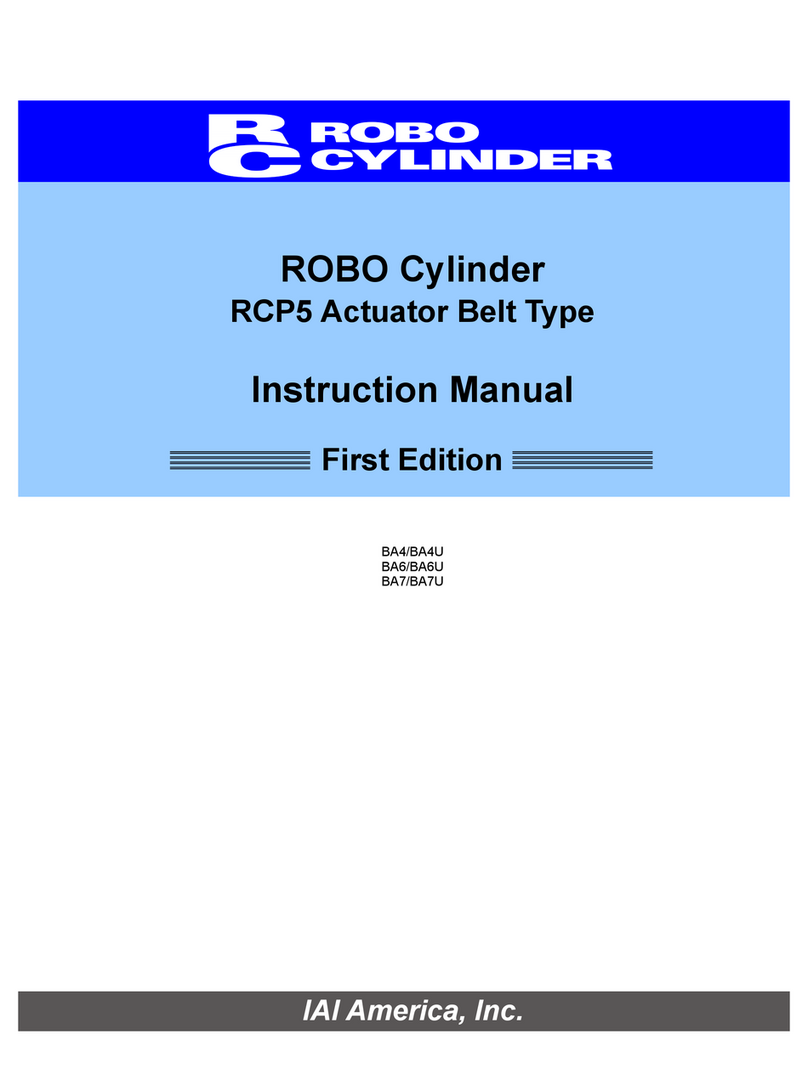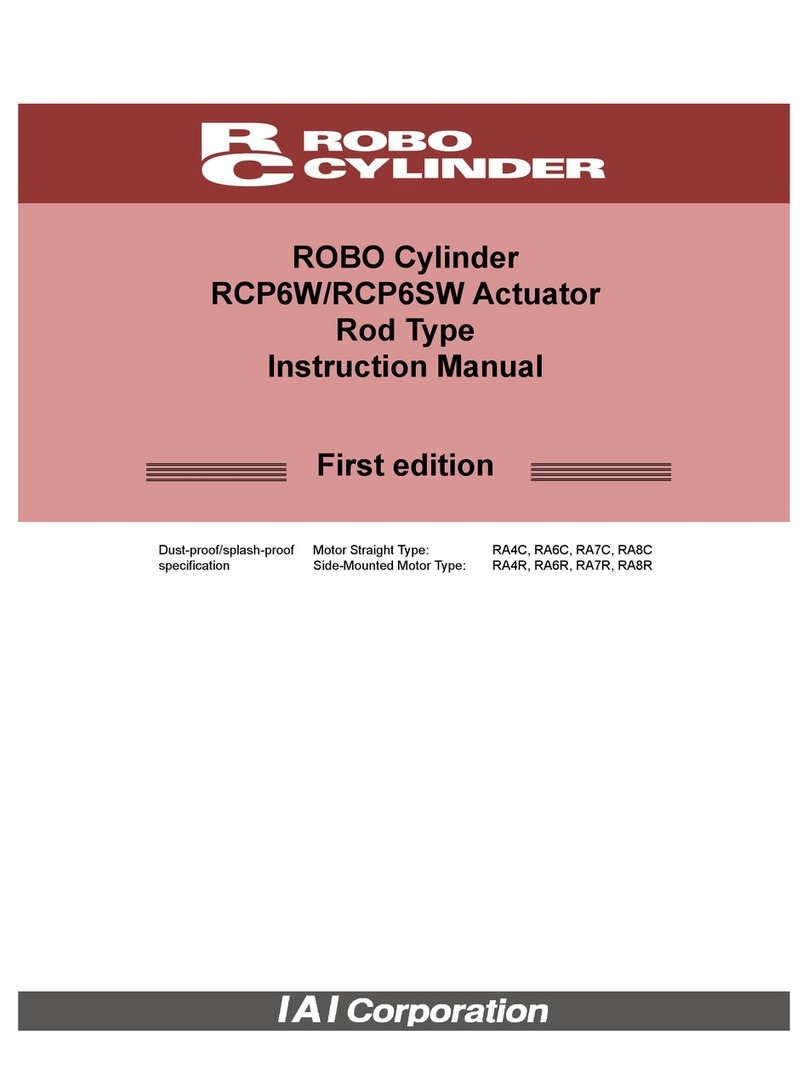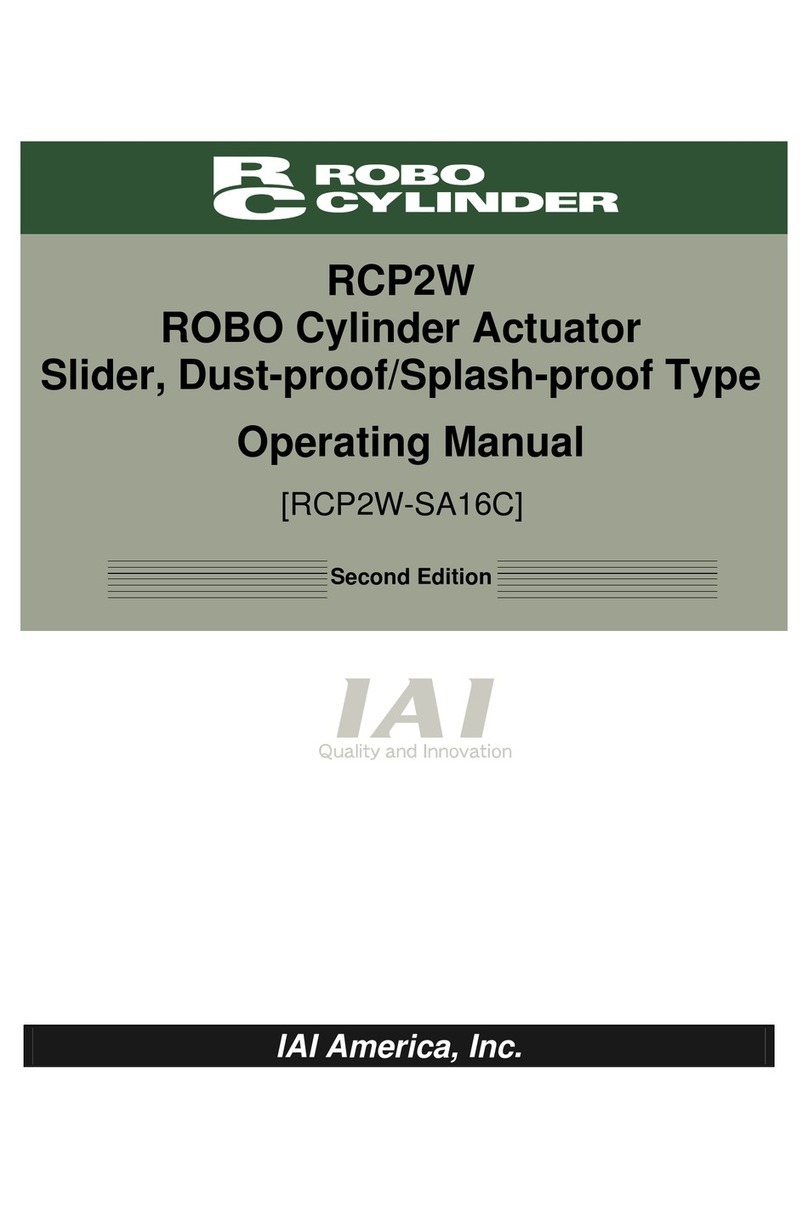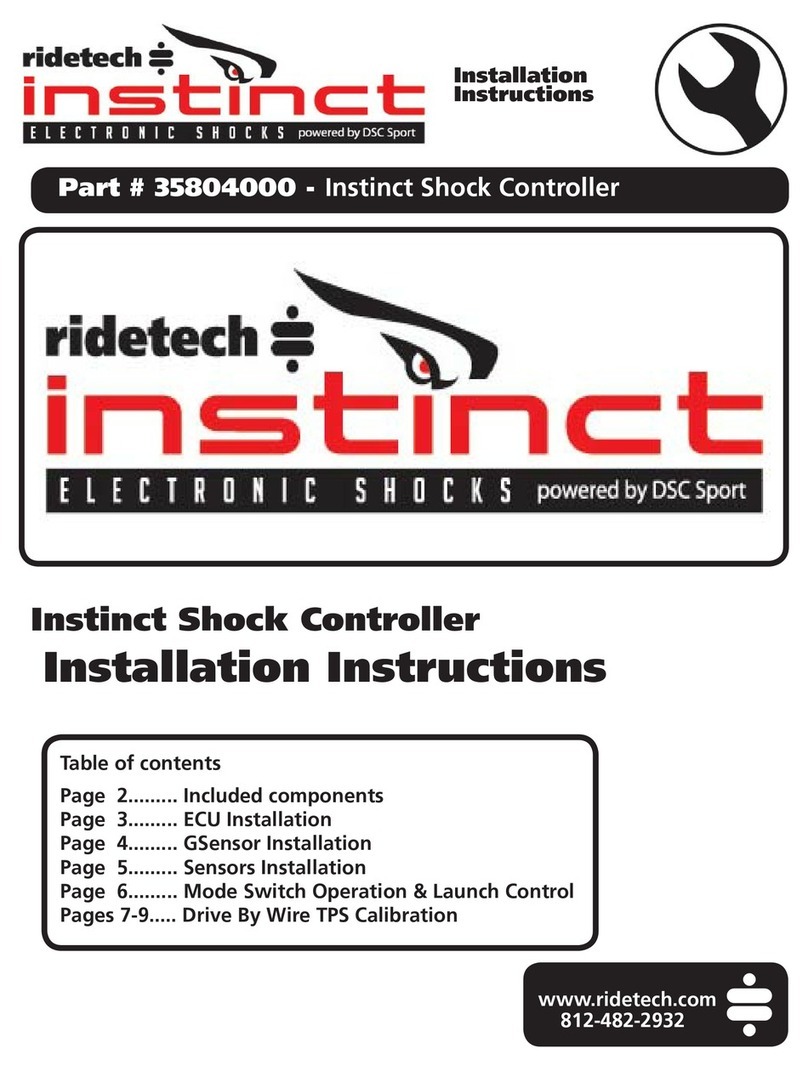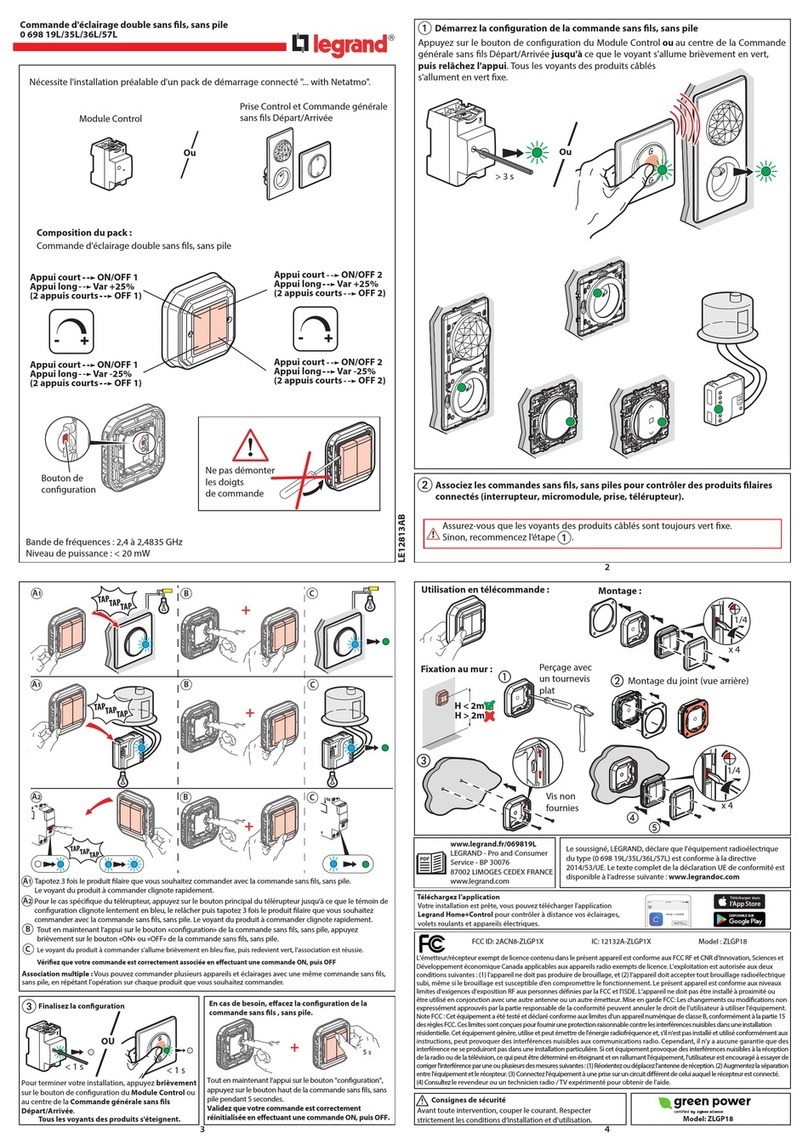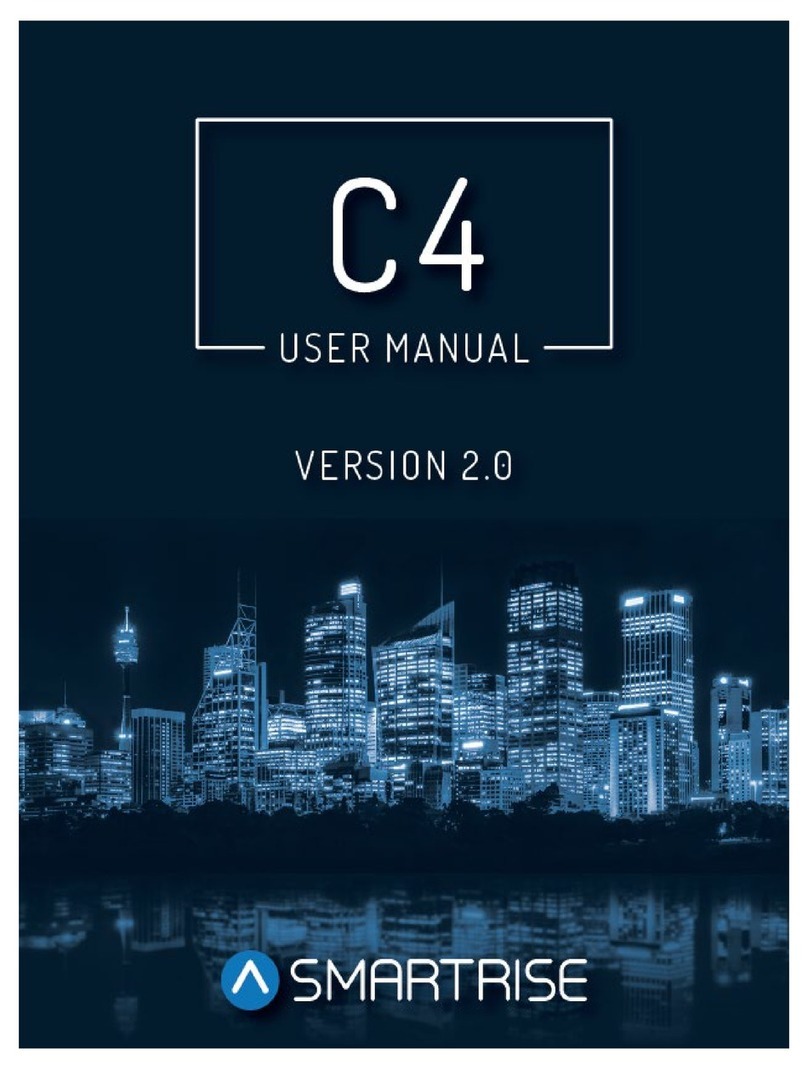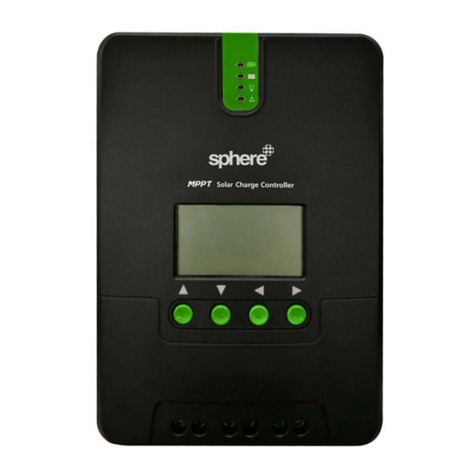ROBO Cylinder GRSS User manual

ROBO Cylinder
RCP2 Actuator Gripper Type
Standard Specification
Instruction Manual
Eleventh Edition
Small Slim Two-finger Slide Type: GRSS
Small Slim Two-finger Lever Type: GRLS
Small and Medium Two-finger Type: GRS / GRM
Two-finger Type with High Gripping Force: GRHM / GRHB
Two-finger Long-stroke Type: GRST
Three-finger Slide Type: GR3SS / GR3SM
Three-finger Lever Type: GR3LS / GR3LM
IAI Co
r
p
oration


Please Read Before Use
Thank you for purchasing our product.
This instruction manual explains the handling methods, structure and maintenance of this product,
among others, providing the information you need to know to use the product safely.
Before using the product, be sure to read this manual and fully understand the contents explained
herein to ensure safe use of the product.
The DVD that comes with the product contains instruction manuals for IAI products.
When using the product, refer to the necessary portions of the applicable instruction manual by
printing them out or displaying them on a PC.
After reading the instruction manual, keep it in a convenient place so that whoever is handling this
product can reference it quickly when necessary.
[Important]
•This instruction manual is original.
•This product is not to be used for any other purpose from what is noted in this instruction
manual. IAI shall not be liable whatsoever for any loss or damage arising from the result of using
the product for any other purpose from what is noted in the manual.
•The information contained in this instruction manual is subject to change without notice for the
purpose of production improvement.
•If you have any question or finding regarding the information contained in this instruction manual,
contact our customer center or our sales office near you.
•Using or copying all or a part of this instruction manual without permission is prohibited.
•The company names, names of products and trademarks of each company shown in the
sentences are registered trademarks.


Table of Contents
Safety Guide........................................................................................................... 1
Caution in Handling ................................................................................................ 8
International Standards Compliances ....................................................................11
1. Specifications Check....................................................................................... 19
1.1 Checking the Product ........................................................................................................ 19
1.1.1 Parts ..................................................................................................................... 19
1.1.2 Instruction Manuals for the Controllers Related to this Product........................... 19
1.1.3 How to Read the Model Nameplate ..................................................................... 20
1.1.4 How to Read the Model Number.......................................................................... 20
1.2 Specifications .................................................................................................................... 21
1.2.1 Common............................................................................................................... 21
1.2.2 Relation between the Current Limit Value and the Grip Force............................. 23
1.2.3 Duty in Continuous Operation .............................................................................. 30
1.3 Operating Conditions......................................................................................................... 31
1.3.1 Grippping Force.................................................................................................... 31
1.4 Option................................................................................................................................ 40
1.4.1 Reversed-home Specification (Model: NM) ......................................................... 40
1.4.2 Shaft Bracket (Model: SB) ................................................................................... 40
1.4.3 Flange Bracket (Model: FB) ................................................................................ 41
1.4.4 Cable Eject Direction Changed (Model: CJT, CJR, CJL, CJB) ............................ 43
1.4.5 Cable Exit from Bottom and Cable Exit from Side (Model: A0, A1) ..................... 43
1.5 Motor • Encoder Cables .................................................................................................... 44
1.5.1 Small Slim Two-finger Slide Type (GRSS), Small Slim Two-finger Lever
Type (GRLS), Two-finger Long-stroke Type (GRST), Two-finger Type with
High Gripping Force (GRHM/GRHB) ................................................................... 44
1.5.2 Small and Medium Two-finger Type (GRS/GRM), Three-finger Slide Type
(GR3SS/GR3SM), Three-finger Lever Type (GR3LS/GR3LM)............................ 46
2. Installation....................................................................................................... 48
2.1 Transportation ................................................................................................................... 48
2.2 Installation and Storage • Preservation Environment........................................................ 50
2.3 How to Install..................................................................................................................... 51
2.3.1 Installation ............................................................................................................ 51
2.3.2 Installation of the Main Unit.................................................................................. 52
2.3.3 Gripper Brackets (Optional) ................................................................................. 63
2.3.4 Installation of Finger Attachments ........................................................................ 67
3. Connecting with the Controller........................................................................ 80
4. Operation........................................................................................................ 85
4.1 Operation of the Fingers.................................................................................................... 85
4.2 Removal of Gripped Work Part ......................................................................................... 87

5. Maintenance and Inspection........................................................................... 89
5.1 Inspection Items and Schedule ......................................................................................... 89
5.2 Visually Inspecting the Exterior ......................................................................................... 90
5.3 Exterior Cleaning............................................................................................................... 90
5.4 Grease Supply for Two-Fingered Small Slim Type, Small Type and Medium Type.......... 90
5.4.1 Guide, Finger and Finger Guide........................................................................... 90
5.5 Feed Screw Small and Medium Two-finger Type (GRS/GRM)......................................... 94
5.6 Two-finger Type with High Gripping Force (GRHM/GRHB) .............................................. 97
5.7 Greasing the Two-finger Long-stroke Type (GRST).......................................................... 99
5.7.1 Greasing to the Feed Screw (Worm/Rack Gears) ............................................... 99
5.7.2 Greasing to the Guide ........................................................................................ 100
5.8 Grease Supply for Three-Fingered Slide Type (GR3SS/GR3SM) .................................. 103
5.8.1 Greasing the Guide, Finger and Finger Guide................................................... 103
5.8.2 Greasing the Gears ............................................................................................ 104
5.9 Grease Supply for Three-Fingered Lever Type (GR3LS/GR3LM).................................. 105
5.9.1 Greasing the Gears ............................................................................................ 105
6. External Dimensions..................................................................................... 106
6.1 GRSS .............................................................................................................................. 106
6.2 GRLS............................................................................................................................... 107
6.3 GRS................................................................................................................................. 108
6.4 GRM ................................................................................................................................ 109
6.5 GRHM.............................................................................................................................. 110
6.6 GRHB ...............................................................................................................................111
6.7 GRST............................................................................................................................... 112
6.8 GR3SS ............................................................................................................................ 113
6.9 GR3SM............................................................................................................................ 114
6.10 GR3LS............................................................................................................................. 115
6.11 GR3LM ............................................................................................................................ 116
7. Warranty ........................................................................................................117
7.1 Warranty Period............................................................................................................... 117
7.2 Scope of the Warranty..................................................................................................... 117
7.3 Honoring the Warranty .................................................................................................... 117
7.4 Limited Liability................................................................................................................ 117
7.5 Conditions of Conformance with Applicable Standards/Regulations, Etc.,
and Applications .............................................................................................................. 118
7.6 Other Items Excluded from Warranty .............................................................................. 118
Change History....................................................................................................119

1
Safety Guide
“Safety Guide” has been written to use the machine safely and so prevent personal injury or property
damage beforehand. Make sure to read it 1before the operation of this product.
Safety Precautions for Our Products
The common safety precautions for the use of any of our robots in each operation.
No. Operation
Description Description
1 Model
Selection
●This product has not been planned and designed for the application
where high level of safety is required, so the guarantee of the protection
of human life is impossible. Accordingly, do not use it in any of the
following applications.
1) Medical equipment used to maintain, control or otherwise affect human
life or physical health.
2) Mechanisms and machinery designed for the purpose of moving or
transporting people (For vehicle, railway facility or air navigation
facility)
3) Important safety parts of machinery (Safety device, etc.)
●Do not use the product outside the specifications. Failure to do so may
considerably shorten the life of the product.
●Do not use it in any of the following environments.
1) Location where there is any inflammable gas, inflammable object or
explosive
2) Place with potential exposure to radiation
3) Location with the ambient temperature or relative humidity exceeding
the specification range
4) Location where radiant heat is added from direct sunlight or other large
heat source
5) Location where condensation occurs due to abrupt temperature
changes
6) Location where there is any corrosive gas (sulfuric acid or hydrochloric
acid)
7) Location exposed to significant amount of dust, salt or iron powder
8) Location subject to direct vibration or impact
●For an actuator used in vertical orientation, select a model which is
equipped with a brake. If selecting a model with no brake, the moving
part may drop when the power is turned OFF and may cause an accident
such as an injury or damage on the work piece.

2
No. Operation
Description Description
2 Transportation ●When carrying a heavy object, do the work with two or more persons or
utilize equipment such as crane.
●When the work is carried out with 2 or more persons, make it clear who is
to be the leader and who to be the follower(s) and communicate well with
each other to ensure the safety of the workers.
●When in transportation, consider well about the positions to hold, weight
and weight balance and pay special attention to the carried object so it
would not get hit or dropped.
●Transport it using an appropriate transportation measure.
The actuators available for transportation with a crane have eyebolts
attached or there are tapped holes to attach bolts. Follow the instructions
in the instruction manual for each model.
●Do not step or sit on the package.
●Do not put any heavy thing that can deform the package, on it.
●When using a crane capable of 1t or more of weight, have an operator
who has qualifications for crane operation and sling work.
●When using a crane or equivalent equipments, make sure not to hang a
load that weighs more than the equipment’s capability limit.
●Use a hook that is suitable for the load. Consider the safety factor of the
hook in such factors as shear strength.
●Do not get on the load that is hung on a crane.
●Do not leave a load hung up with a crane.
●Do not stand under the load that is hung up with a crane.
3 Storage and
Preservation
●The storage and preservation environment conforms to the installation
environment. However, especially give consideration to the prevention of
condensation.
●Store the products with a consideration not to fall them over or drop due
to an act of God such as earthquake.
4 Installation
and Start
(1) Installation of Robot Main Body and Controller, etc.
●Make sure to securely hold and fix the product (including the work part). A
fall, drop or abnormal motion of the product may cause a damage or
injury.
Also, be equipped for a fall-over or drop due to an act of God such as
earthquake.
●Do not get on or put anything on the product. Failure to do so may cause
an accidental fall, injury or damage to the product due to a drop of
anything, malfunction of the product, performance degradation, or
shortening of its life.
●When using the product in any of the places specified below, provide a
sufficient shield.
1) Location where electric noise is generated
2) Location where high electrical or magnetic field is present
3) Location with the mains or power lines passing nearby
4) Location where the product may come in contact with water, oil or
chemical droplets

3
No. Operation
Description Description
(2) Cable Wiring
●Use our company’s genuine cables for connecting between the actuator
and controller, and for the teaching tool.
●Do not scratch on the cable. Do not bend it forcibly. Do not pull it. Do not
coil it around. Do not insert it. Do not put any heavy thing on it. Failure to
do so may cause a fire, electric shock or malfunction due to leakage or
continuity error.
●Perform the wiring for the product, after turning OFF the power to the
unit, so that there is no wiring error.
●When the direct current power (+24V) is connected, take the great care
of the directions of positive and negative poles. If the connection direction
is not correct, it might cause a fire, product breakdown or malfunction.
●Connect the cable connector securely so that there is no disconnection
or looseness. Failure to do so may cause a fire, electric shock or
malfunction of the product.
●Never cut and/or reconnect the cables supplied with the product for the
purpose of extending or shortening the cable length. Failure to do so may
cause the product to malfunction or cause fire.
4 Installation
and Start
(3) Grounding
●The grounding operation should be performed to prevent an electric
shock or electrostatic charge, enhance the noise-resistance ability and
control the unnecessary electromagnetic radiation.
●For the ground terminal on the AC power cable of the controller and the
grounding plate in the control panel, make sure to use a twisted pair
cable with wire thickness 0.5mm2(AWG20 or equivalent) or more for
grounding work. For security grounding, it is necessary to select an
appropriate wire thickness suitable for the load. Perform wiring that
satisfies the specifications (electrical equipment technical standards).
●Perform Class D Grounding (former Class 3 Grounding with ground
resistance 100Ωor below).

4
No. Operation
Description Description
4 Installation
and Start
(4) Safety Measures
●When the work is carried out with 2 or more persons, make it clear who is
to be the leader and who to be the follower(s) and communicate well with
each other to ensure the safety of the workers.
●When the product is under operation or in the ready mode, take the
safety measures (such as the installation of safety and protection fence)
so that nobody can enter the area within the robot’s movable range.
When the robot under operation is touched, it may result in death or
serious injury.
●Make sure to install the emergency stop circuit so that the unit can be
stopped immediately in an emergency during the unit operation.
●Take the safety measure not to start up the unit only with the power
turning ON. Failure to do so may start up the machine suddenly and
cause an injury or damage to the product.
●Take the safety measure not to start up the machine only with the
emergency stop cancellation or recovery after the power failure. Failure
to do so may result in an electric shock or injury due to unexpected
power input.
●When the installation or adjustment operation is to be performed, give
clear warnings such as “Under Operation; Do not turn ON the power!”
etc. Sudden power input may cause an electric shock or injury.
●Take the measure so that the work part is not dropped in power failure or
emergency stop.
●Wear protection gloves, goggle or safety shoes, as necessary, to secure
safety.
●Do not insert a finger or object in the openings in the product. Failure to
do so may cause an injury, electric shock, damage to the product or fire.
●When releasing the brake on a vertically oriented actuator, exercise
precaution not to pinch your hand or damage the work parts with the
actuator dropped by gravity.
5 Teaching ●When the work is carried out with 2 or more persons, make it clear who is
to be the leader and who to be the follower(s) and communicate well with
each other to ensure the safety of the workers.
●Perform the teaching operation from outside the safety protection fence,
if possible. In the case that the operation is to be performed unavoidably
inside the safety protection fence, prepare the “Stipulations for the
Operation” and make sure that all the workers acknowledge and
understand them well.
●When the operation is to be performed inside the safety protection fence,
the worker should have an emergency stop switch at hand with him so
that the unit can be stopped any time in an emergency.
●When the operation is to be performed inside the safety protection fence,
in addition to the workers, arrange a watchman so that the machine can
be stopped any time in an emergency. Also, keep watch on the operation
so that any third person can not operate the switches carelessly.
●Place a sign “Under Operation” at the position easy to see.
●When releasing the brake on a vertically oriented actuator, exercise
precaution not to pinch your hand or damage the work parts with the
actuator dropped by gravity.
* Safety protection Fence : In the case that there is no safety protection fence,
the movable range should be indicated.

5
No. Operation
Description Description
6 Trial Operation ●When the work is carried out with 2 or more persons, make it clear who is
to be the leader and who to be the follower(s) and communicate well with
each other to ensure the safety of the workers.
●After the teaching or programming operation, perform the check
operation one step by one step and then shift to the automatic operation.
●When the check operation is to be performed inside the safety protection
fence, perform the check operation using the previously specified work
procedure like the teaching operation.
●Make sure to perform the programmed operation check at the safety
speed. Failure to do so may result in an accident due to unexpected
motion caused by a program error, etc.
●Do not touch the terminal block or any of the various setting switches in
the power ON mode. Failure to do so may result in an electric shock or
malfunction.
7 Automatic
Operation
●Check before starting the automatic operation or rebooting after
operation stop that there is nobody in the safety protection fence.
●Before starting automatic operation, make sure that all peripheral
equipment is in an automatic-operation-ready state and there is no alarm
indication.
●Make sure to operate automatic operation start from outside of the safety
protection fence.
●In the case that there is any abnormal heating, smoke, offensive smell, or
abnormal noise in the product, immediately stop the machine and turn
OFF the power switch. Failure to do so may result in a fire or damage to
the product.
●When a power failure occurs, turn OFF the power switch. Failure to do so
may cause an injury or damage to the product, due to a sudden motion of
the product in the recovery operation from the power failure.

6
No. Operation
Description Description
8 Maintenance
and Inspection
●When the work is carried out with 2 or more persons, make it clear who is
to be the leader and who to be the follower(s) and communicate well with
each other to ensure the safety of the workers.
●Perform the work out of the safety protection fence, if possible. In the
case that the operation is to be performed unavoidably inside the safety
protection fence, prepare the “Stipulations for the Operation” and make
sure that all the workers acknowledge and understand them well.
●When the work is to be performed inside the safety protection fence,
basically turn OFF the power switch.
●When the operation is to be performed inside the safety protection fence,
the worker should have an emergency stop switch at hand with him so
that the unit can be stopped any time in an emergency.
●When the operation is to be performed inside the safety protection fence,
in addition to the workers, arrange a watchman so that the machine can
be stopped any time in an emergency. Also, keep watch on the operation
so that any third person can not operate the switches carelessly.
●Place a sign “Under Operation” at the position easy to see.
●For the grease for the guide or ball screw, use appropriate grease
according to the instruction manual for each model.
●Do not perform the dielectric strength test. Failure to do so may result in
a damage to the product.
●When releasing the brake on a vertically oriented actuator, exercise
precaution not to pinch your hand or damage the work parts with the
actuator dropped by gravity.
●The slider or rod may get misaligned OFF the stop position if the servo is
turned OFF. Be careful not to get injured or damaged due to an
unnecessary operation.
●Pay attention not to lose the cover or untightened screws, and make sure
to put the product back to the original condition after maintenance and
inspection works.
Use in incomplete condition may cause damage to the product or an
injury.
* Safety protection Fence : In the case that there is no safety protection
fence, the movable range should be indicated.
9 Modification
and Dismantle
●Do not modify, disassemble, assemble or use of maintenance parts not
specified based at your own discretion.
10 Disposal ●When the product becomes no longer usable or necessary, dispose of it
properly as an industrial waste.
●When removing the actuator for disposal, pay attention to drop of
components when detaching screws.
●Do not put the product in a fire when disposing of it.
The product may burst or generate toxic gases.
11 Other ●Do not come close to the product or the harnesses if you are a person
who requires a support of medical devices such as a pacemaker. Doing
so may affect the performance of your medical device.
●See Overseas Specifications Compliance Manual to check whether
complies if necessary.
●For the handling of actuators and controllers, follow the dedicated
instruction manual of each unit to ensure the safety.

7
Alert Indication
The safety precautions are divided into “Danger”, “Warning”, “Caution” and “Notice” according to the
warning level, as follows, and described in the instruction manual for each model.
Level Degree of Danger and Damage Symbol
Danger This indicates an imminently hazardous situation which, if the product
is not handled correctly, will result in death or serious injury. Danger
Warning This indicates a potentially hazardous situation which, if the product is
not handled correctly, could result in death or serious injury. Warning
Caution This indicates a potentially hazardous situation which, if the product is
not handled correctly, may result in minor injury or property damage. Caution
Notice This indicates lower possibility for the injury, but should be kept to use
this product properly. Notice

8
Caution in Handling
1. Make sure to follow the usage condition, environment and specification
range of the product.
In case it is not secured, it may cause a drop in performance or malfunction of the product.
2. Do not attempt to have any handling or operation that is not stated in this
instruction manual.
3. It is recommended to apply our products for the wiring between the actuator
and the controller.
4. Do not attempt to establish the settings for the speed and acceleration/
deceleration above the allowable range.
An operation with speed and acceleration/deceleration beyond the allowable range may cause an
abnormal noise, vibration, malfunction or shortened life.
5. Set the allowable moment within the allowable range.
An operation with the load beyond the allowable moment may cause an abnormal noise, vibration,
malfunction or shortened life. If it is extreme, flaking may occur on the guide.
6. Make sure to attach the actuator properly by following this instruction
manual.
Using the product with the actuator not being certainly retained or affixed may cause abnormal
noise, vibration, malfunction or shorten the product life.
7. In case of removing the grease applied on the fingers and finger guides
after delivery, make sure to implement a rust prevention treatment.
Applicable models : GRSS, GRS, GRM, GR3SS, GR3SM
There is grease applied on the fingers and finger guides at the delivery for rust prevention
treatment.
The fingers and finger guides may gather rust if the grease is wiped away.
Also, have grease or an anti-rust agent applied on the fingers and finger guides regularly.
[Refer to 5.4.1 Guide, Finger and Finger Guide in 5.4 Grease Supply for Two-Fingered Small Slim
Type, Small Type and Medium Type, or 5.8.1 Greasing the Guide, Finger and Finger Guide in 5.8
Grease Supply for Three-Fingered Slide Type (GR3SS/GR3SM) for how to supply grease]
Two-Finger Type Three-Finger Type
Finger Guide
Finger Guide
Finger Guide
Finger
Finger
Finger
Finger Guide
Finger

9
8. Make sure to follow the cautions listed below when transferring a work
piece.
If the fingers receive a strong force or impact other than the gripping force when transferring work
parts, the finger positions may deviate, looseness may occur or damage may result. Accordingly,
pay due attention to the points listed below.
¡Cause the center of gravity of the work part to match the gripping point as much as possible. If
the two are not aligned, gravitational moments will force the work part to assume an unstable
posture.
Center of gravity of
the work part
Gripping point
Unstable
¡While being gripped, the work part should have play (clearance) in the gripping direction. Also
perform thorough alignment and avoid using the gripper in a manner where loads concentrate
on one finger alone when a work part is gripped.
No clearance is
available. Loads are
received unevenly.
Clearance is available.

10
¡Avoid using the gripper in a manner where it press-fits a gripped work part into a hole or pulls
out a work part that has been press-fit.
Do not press-fit a
work part.
Do not pull out a
press-fit work part.
¡Avoid pushing a work part against a jig, etc., at the end of the movement stroke when the work
part is moved or reversed.
Do not push a work part. Do not push a work part.
¡When inserting a work part into a hole, provide a sufficient clearance by anticipating positional
variation. Also perform thorough alignment. (Pay attention to contact at the time of insertion.)
Clearance is available. No clearance is available.
An impact load is received.
Not aligned.

11
International Standards Compliances
This actuator complies with the following overseas standard.
Refer to Overseas Standard Compliance Manual (ME0287) for more detailed information.
RoHS Directive CE Marking
cc

12
Names of the Parts
1. Small Slim Two-finger Slide Type: GRSS
Finger guide
Open/close
screw
Finger
Finger
Frame
Motor cover PG cable
M cable
Motor cover lid
Front Rear
Right
Left

13
2. Small Slim Two-finger Slide Type: GRLS
Lever L
Open/close
screw
Lever R
Frame
Motor cover
M cable
PG cable
Front Rear
Right
Left

14
3. Small and Medium Two-finger Type: GRS/GRM
Right
Left
Front Rear
Side cover L
Side cover R Frame
Finger guide
Actuator cable
Finger R
Finger L
Guide cover R
Open/close screw
Guide cover L
This manual suits for next models
10
Table of contents
Other ROBO Cylinder Controllers manuals
Popular Controllers manuals by other brands

Imron Corporation
Imron Corporation S0-16 Installation and Specification
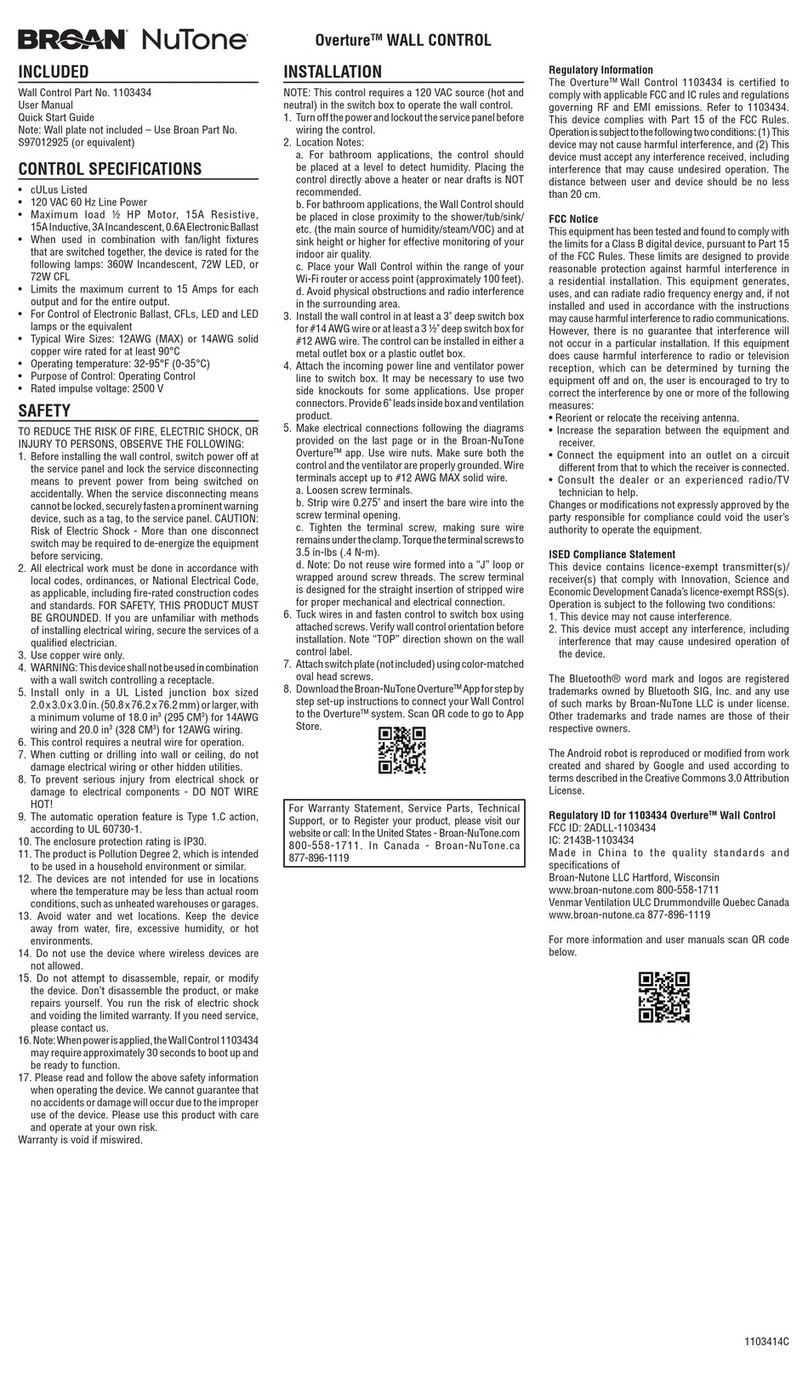
NuTone
NuTone Overture 1103434 user manual
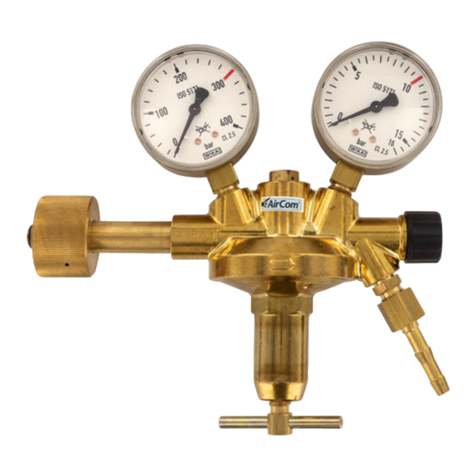
AirCom
AirCom RH300 operating manual
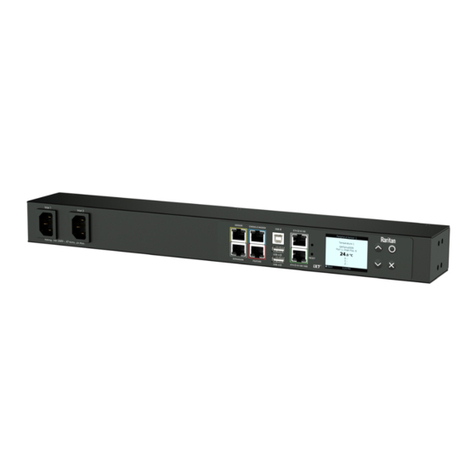
LEGRAND
LEGRAND Raritan Smart Rack Controller Quick setup guide
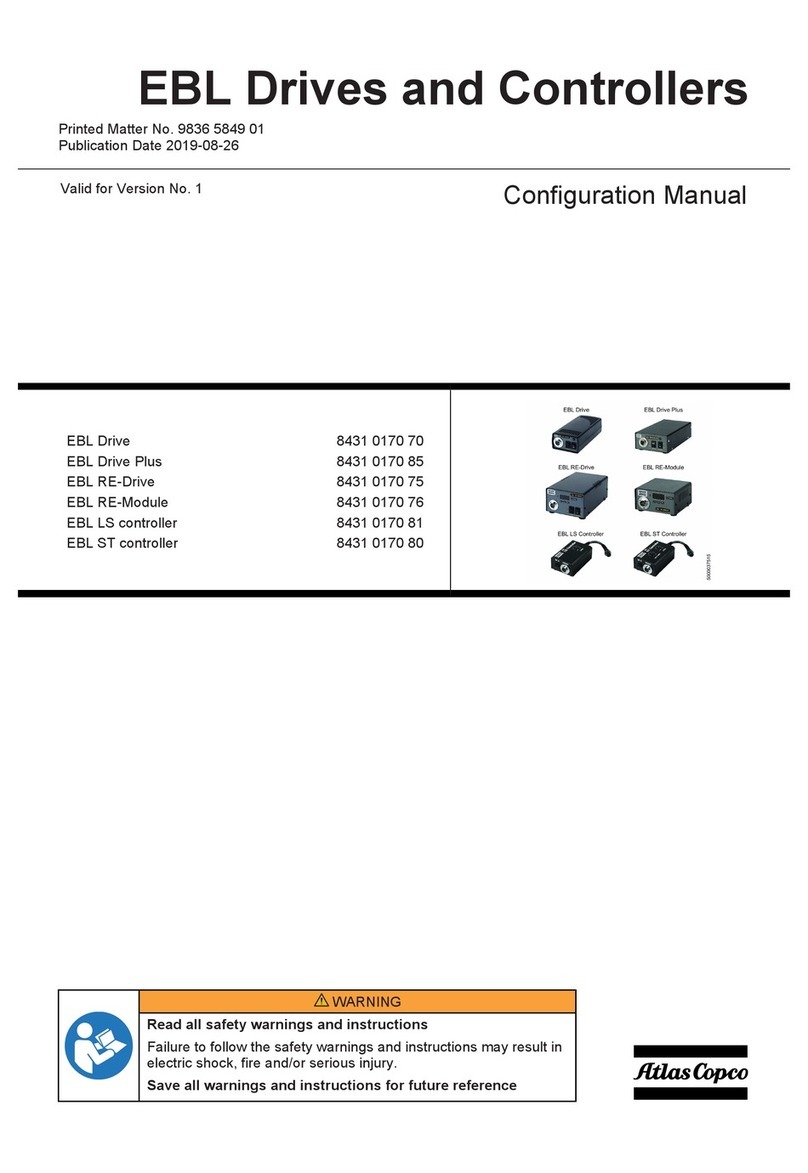
Atlas Copco
Atlas Copco EBL Drive Configuration manual
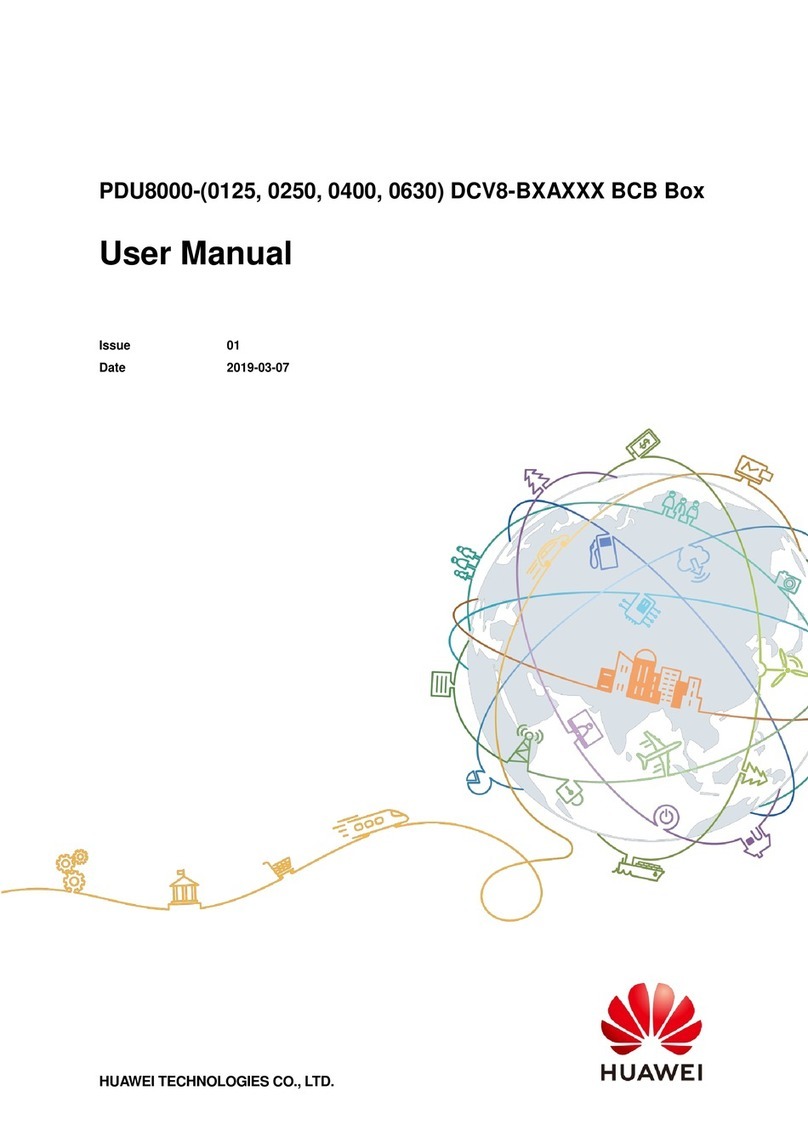
Huawei
Huawei PDU8000-0125DCV8-BXA006 user manual
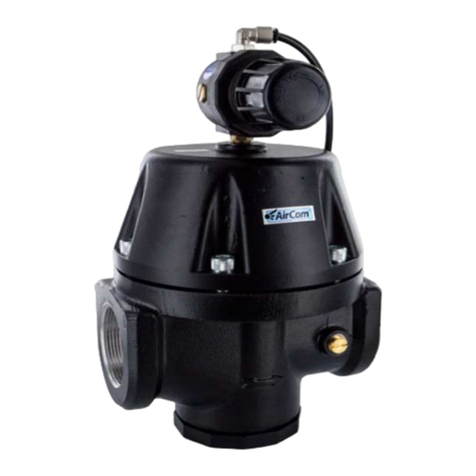
AirCom
AirCom R119 operating manual
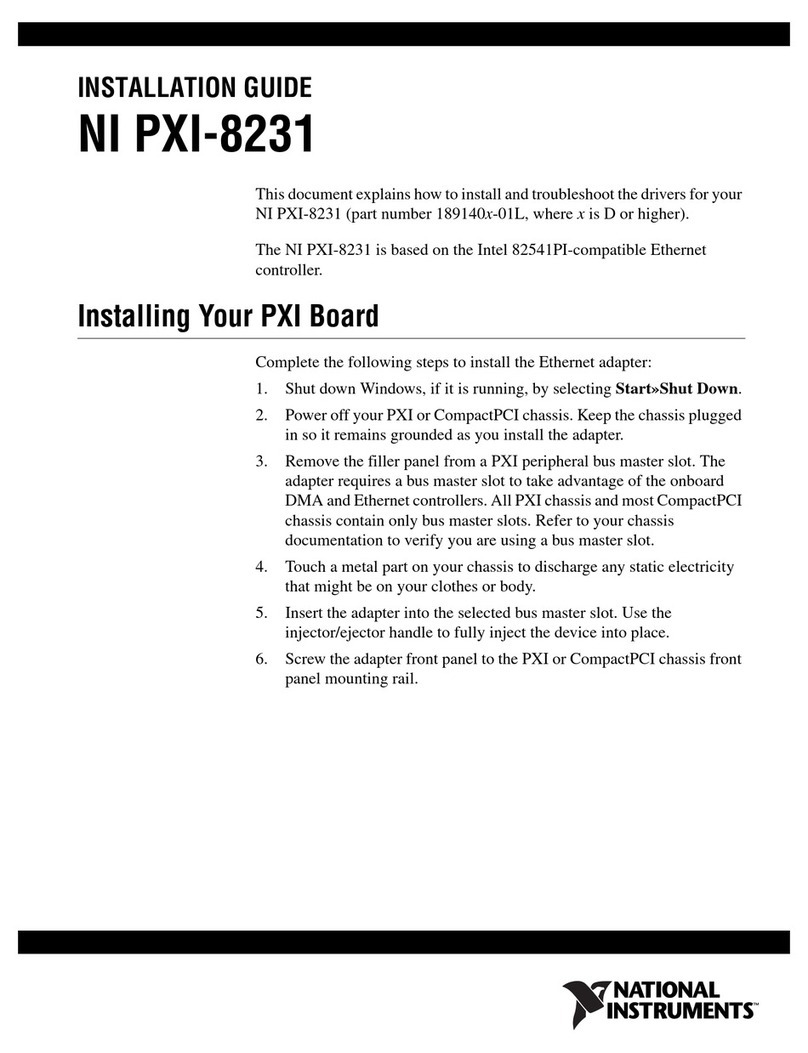
National Instruments
National Instruments PXI-8231 installation guide
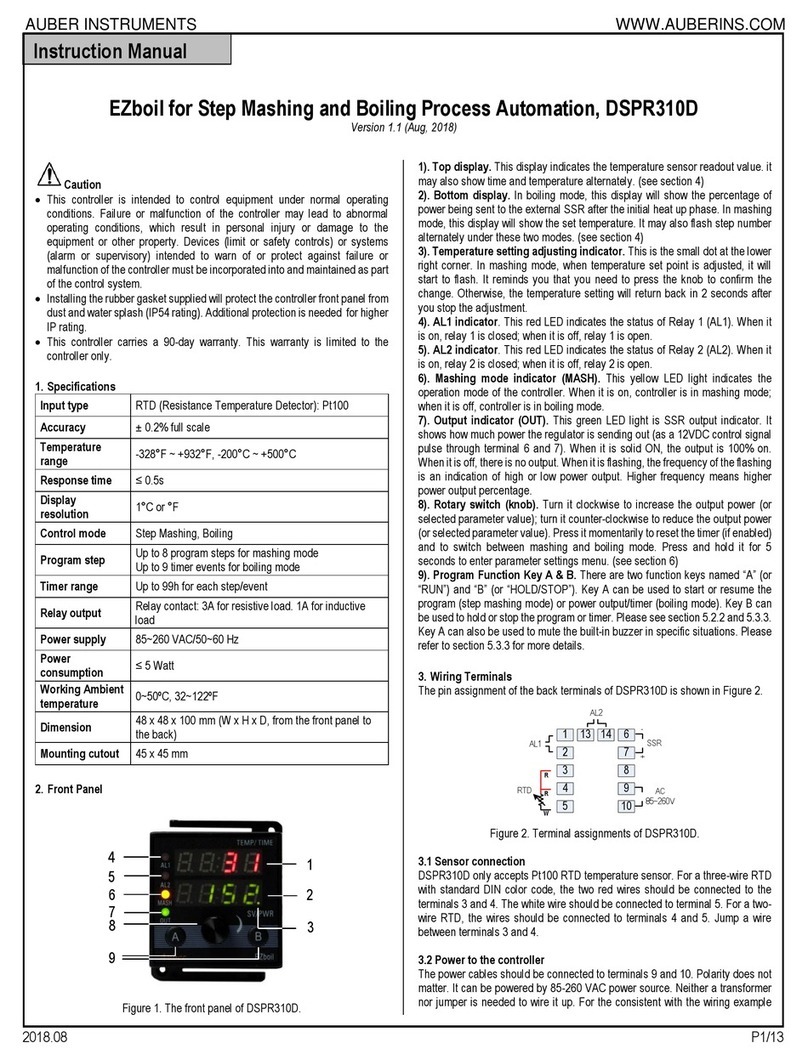
Auber Instruments
Auber Instruments EZboil DSPR310D instruction manual
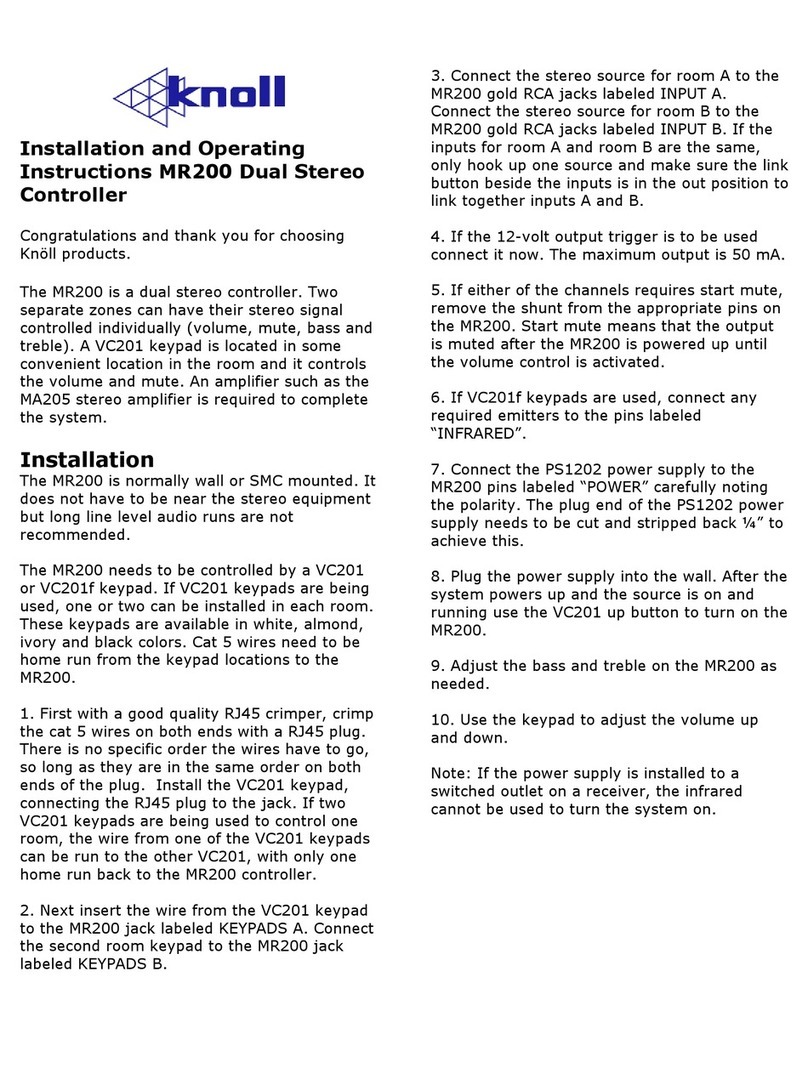
Knoll
Knoll MR200 Installation and operating instructions
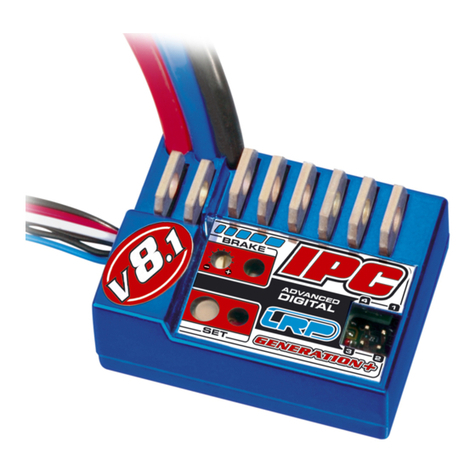
LRP electronic
LRP electronic IPC V8.1 GENERATION+ user guide
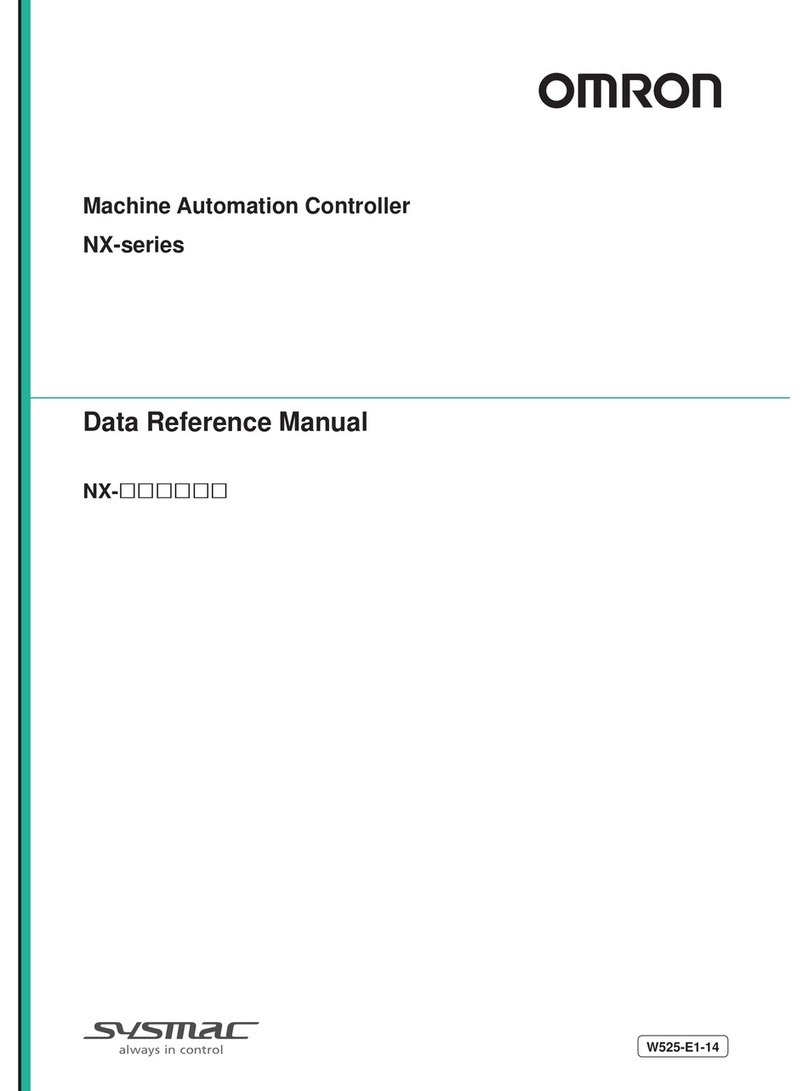
Omron
Omron NX Series Reference manual
